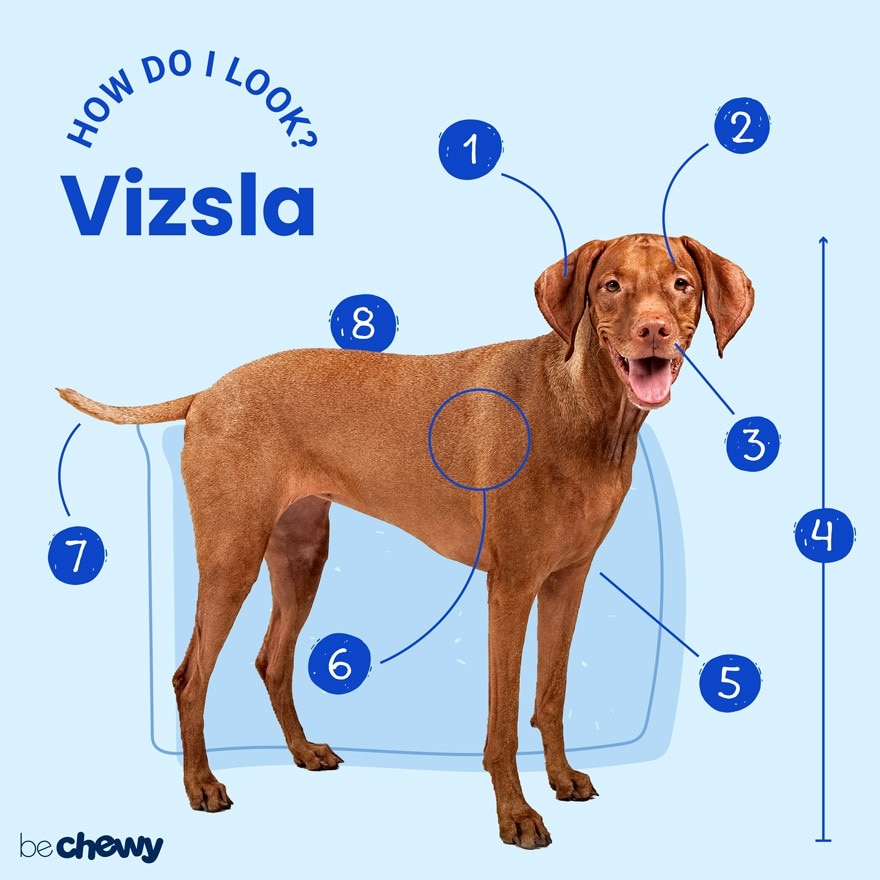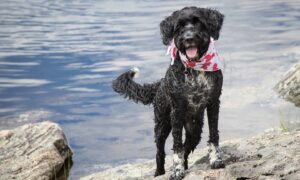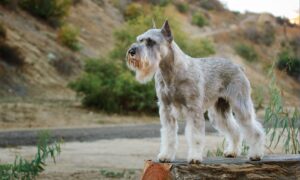Vizsla
Updated January 7, 2025
Vizsla
Updated January 7, 2025
Athletic, Gentle, Fearless
Male: 55-60 pounds
Female: 44-55 pounds
Male: 22-24 inches
Female: 21-23 inches
12 to 14 years
Golden Rust
So, you may not have known this, but you’re gonna need a faster bike. Yup, thanks to your Vizsla, trading in your regular wheels for an electric upgrade is a must. Sure, the Vizsla breed isn’t a large dog, but this wiggly, wild creature is lightning fast, running like the wind any time they get the chance. (You might want to think about starting an exercise routine if you don’t have one already.) Non-stop energy, sleek good looks and long ears that cradle the sweetest face will prompt you to show off your Vizsla dog. But there’s just one problem. You. Can’t. Catch. Up. On second thought, skip the e-bike—and get a Vespa.
Vizsla Characteristics
Vizsla Appearance
A Vizsla dog’s smooth golden rust coat and delicate droopy ears are two distinctive features that entice potential pet parents to welcome this handsome pup into their homes. Add in a lean, muscular frame, gentle eyes and a curious, intelligent face and you can see why this ancient hunting dog attracts so many canine fans.

- Ears
Vizsla ears hang close to the cheeks and are thin and silky with rounded edges.
- Eyes
Vizsla eyes are medium in size and tend to blend in with the dog's coat color.
- Nose
The Vizsla dog breed's nose is rounded and the same golden rust color as their fur.
- Coat Length
The Vizsla dog breed is short-coated with smooth, dense, close-lying fur.
- Coat Color
A Vizsla's coat sports shades of golden rust.
- TailThe AKC breed standard calls for the tail to be docked. Docking involves cutting a portion of the dog’s tail off when they are puppies. Veterinary groups along with many U.S. states and countries have banned this procedure due to medical and behavioral reasons. If you are interested in this procedure, schedule a consultation with your veterinarian.
Vizsla Temperament
Bounding, wiggling, racing away—the Vizsla dog breed has a high-energy personality that’s always ready to go, go, go. (Keeping up with the Energizer Bunny would not be an issue). Inquisitive and loving, a Vizsla is sometimes called a “Velcro dog” as they tend to stick close to their people. Vizslas have a gentle, friendly nature and a playful demeanor.
Having a Vizsla in a home with kids and babies is a fine idea—and the breed also enjoys the company of other dogs, especially when they’re young. Bonus: They can even be trained to live peaceably with cats. But keep in mind that Vizslas have a high prey drive and may chase a kitty, so if you plan to introduce a feline to the family, take care to keep the cat safe until your Vizsla puppy is well socialized.
Vizsla qualities also include a high level of competence and an ability to learn quickly, making this dog highly trainable. Vizsla intelligence has long been prized; the breed has a distinguished history as a faithful hunting companion that was bred to both point and retrieve. Modern-day Vizslas have equally demanding jobs as seeing eye dogs, search and rescue animals and professional sniffers (think drugs or explosives). And Vizslas even have a patriotic streak, serving as canine recovery workers at Ground Zero in New York City after the attacks on September 11, 2001.
How to Care for a Vizsla
A Vizsla guide to care puts great emphasis on physical exercise and mental stimulation to keep this extremely active canine happy. Luckily, health and wellness are breed hallmarks and Vizsla grooming is quick and easy.
Grooming
Training
Diet
Exercise
Environment
Vizsla Health
The Vizsla lifespan is a generous one (up to 14 years), and the breed is considered healthy. Still, all dogs are prone to certain health problems. Here’s a look at the common Vizsla health issues you might encounter with this medium-sized canine:
- Eye Disorders: Vizslas are prone to several eye conditions, including ocular melanosis, an inherited disease that thickens and discolors the iris and can cause glaucoma in some cases. While there’s no cure, anti-inflammatory and glaucoma medications can help. Entropion, a rolling inward of the eyelids that results in the lashes irritating the cornea, is another eye disorder, with surgery as the treatment. Progressive retinal atrophy (PRA) is a degenerative, hereditary eye disease that may result in blindness. Dogs with PRA can usually adapt to this vision loss, though there’s currently no treatment for it.
- Epilepsy: This inherited seizure disorder may be partial or generalized, but fortunately, it may be managed with anti-epileptic medications.
- Hip Dysplasia: Hip dysplasia occurs when the hip joint does not form properly as a dog grows. This leads to looseness in the hip joint, which can cause pain and lameness, and will eventually lead to degenerative arthritis. Hip dysplasia is genetic in origin and can be treated with medications and supplements, dietary changes or weight reduction. In more severe cases, surgery may be necessary.
- Thyroid Conditions: Hypothyroidism, typically caused by the degeneration or destruction of the thyroid gland, leads to slower metabolism. This may appear as lethargy, weight gain, skin and coat changes or other signs in your Vizsla. Thyroid supplementation is the go-to treatment.
Vizsla History
The Vizsla’s history is inextricably linked to the Magyars, an ethnic Hungarian group who traversed a wide-ranging swath of Asia and Europe centuries ago before settling in what is now Hungary. The Magyars’ prowess on horseback was legendary as was their ability to ride fast with equally fleet-footed dogs at their sides. Their canine pals featured reddish-brown coats—and today’s Vizslas are their descendants.
Originally bred as Magyar companions in their quest for dominance across the continent, Vizslas later became the favored hunting breed of Hungarian nobles. Vizslas were actually early multitaskers because they served two jobs as pointers and retrievers of rabbits, upland game (quail, partridge) and waterfowl (ducks).
At the end of World War I, the Vizsla breed was nearly extinct, with just a handful of purebreds in existence. Fortunately, breed enthusiasts were able to repopulate the dog again, and they began to arrive in the US after World War II in the 1950s. The Vizsla was recognized by the American Kennel Club (AKC) in 1960 and has grown to become a popular family pet ever since.
Vizslas continue to display great versatility as working canines in many different capacities, including that of seeing-eye dog, on drug detection details for the Transportation Security Administration and as part of search and rescue teams at disaster sites, including the one that occurred in New York City on September 11, 2001.
If you’d like to bring this energetic pup into your home, Vizsla dog prices tend to be about $2,000 from a breeder. The AKC Marketplace has information about Vizsla puppies for sale. You can also reach out to Vizsla rescue organizations, keep an eye out for the breed at your local animal shelter or search Chewy’s database of adoptable dogs in your area.
FAQs
Do Vizslas shed?
How do you pronounce Vizsla?
What are the most popular Vizsla dog names?
Are Vizslas good family dogs?
Are Vizslas smart dogs?
What are the most common Vizsla dog mixes?
Expert input provided by veterinarian Carly Fox, DVM, of Animal Medical Center in New York City and dog trainers Margaret Simek of One Happy Dog and Mary Thompson, owner of Happy Hound University.
Breed characteristic ratings provided by veterinarian Dr. Sarah J. Wooten, DVM, CVJ, a veterinarian at Sheep Draw Veterinary Hospital in Greeley, Colorado; dog trainer and behavior consultant Irith Bloom, CPDT-KSA, CBCC-KA, CDBC, owner of The Sophisticated Dog, LLC, in Los Angeles; and certified animal behavior consultant Amy Shojai, CABC, in Sherman, Texas.
The health content was medically reviewed by Chewy vets.
























